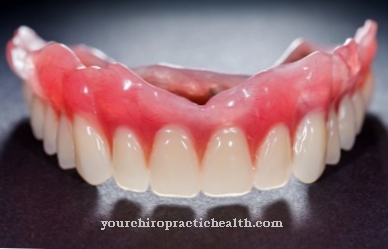Of the Rubber dam is a system that protects the teeth from disturbing influences during treatment. This system can be used to isolate individual teeth for treatment.
What is rubber dam?

The rubber dam is used to shield the teeth to be treated from unwanted influences such as saliva or bacteria. It also protects the patient from swallowing and breathing in harmful residues during dental treatment. This includes amalgam residues, pathogens, crown residues, parts of the treatment tools (e.g. drill tips) and much more.
The treated tooth should be kept as dry as possible during the treatment and, during root canal treatments, the root canal should be protected from invading bacteria.
A rubber dam is a rubber dam that is stretched in front of the teeth that are not to be treated, while the teeth to be treated are isolated by holes in the rubber. This protection method was introduced by the New York dentist Sanford Christie Barnum in 1864. After the introduction of suction systems in the sixties of the twentieth century, the rubber dam slowly lost its importance again. However, more and more dentists are now appreciating the advantages of rubber dams. According to the DGZMK (German Society for Dentistry, Oral and Kiefernheilkunde), important dental treatments should be performed with the help of a rubber dam. However, there is no mandatory obligation to do so.
Shapes, types & types
The use of rubber dams has proven itself in root canal treatments, placing plastic or gold fillings, removing amalgam residues, teeth whitening or adhesive fillings. Among other things, it prevents contact of the root canal with invading pathogens or contact of the gums with the corrosive substances of the bleaching or the adhesive fillings.
The rubber dam consists of a rubber strap made of latex. A material that does not contain latex was also brought onto the market for allergy sufferers. The so-called rubber dam clamps are used to fasten the elastic on the teeth. In addition to the rubber dam clamps, threads, wet jets (dental floss) or interdental wedges can also be used. Clamp pliers and punch pliers for punching holes for the teeth to be treated are also required as accessories. Furthermore, a clamping frame is also included to stretch the rubber in front of the mouth.
In addition to this basic equipment, however, more recent developments are already on the market. There are ergonomic rubber dams with a knob-like design, where the marking of the hole positions and the punching out of the holes are not necessary. In some new developments, plastic rings are integrated, which makes fastening with clips superfluous. Other systems already have a perforated elastic band. These further developments of the rubber dam systems are intended to increase their acceptance, which is still quite low today due to the sometimes cumbersome handling.
Structure & functionality
The way the rubber dam systems work is very simple. Since the tooth has to be kept dry during a root canal treatment or when a plastic filling is placed, the rubber dam offers good protection against moisture from the saliva or damp breath. There is no need for constant suction. The same applies to shielding the tooth from pathogens from the oral cavity.
When treating isolated, free-standing teeth, caustic substances or drug solutions are often used, which cannot be swallowed by using this system. There is also no risk of swallowing tooth residues or amalgam residues.
For this purpose, the elastic is first stretched in front of the mouth by means of the tensioning frame. Then the rubber is slipped over the teeth that are not to be treated. There it is attached with the rubber dam clamps. The teeth or groups of teeth to be treated then protrude from the previously punched holes in the rubber. When treating gingivitis, the gums can also be isolated from the tooth using a rubber dam.
The mouth is kept open with the rubber dam. The dentist can concentrate on treating the teeth in peace, while the patient can swallow in peace.
You can find your medication here
➔ Toothache medicationIllnesses & ailments
The use of a rubber dam has many advantages. However, there are also disadvantages and contraindications. When the rubber dam is under tension, the dentist no longer has to worry about suctioning the teeth. In addition, tooth remnants, components of old fillings or broken parts of treatment tools are more easily visible to him. His work is also made easier because the patient's mouth remains open during the entire treatment period.
The benefit for the patient is that by keeping the treated tooth dry, for example, a plastic filling can sometimes be more firmly seated or the contamination of the root canal with the bacteria of the oral mucosa is prevented during a root canal treatment. This increases the chances of recovery enormously. Even severe gingivitis (inflammation of the gums) can be treated better because the focus of inflammation becomes visible through the isolation of the gums from the tooth.
However, the compressive stress of the rubber dam clamps can lead to pressure sores in the gums. The displacement of the gums from the tooth for the treatment of previously invisible areas can also cause trauma to the gums.
Contraindications to putting on a rubber dam are present in epilepsy, allergies, asthma, respiratory diseases or anxiety disorders.

























.jpg)


